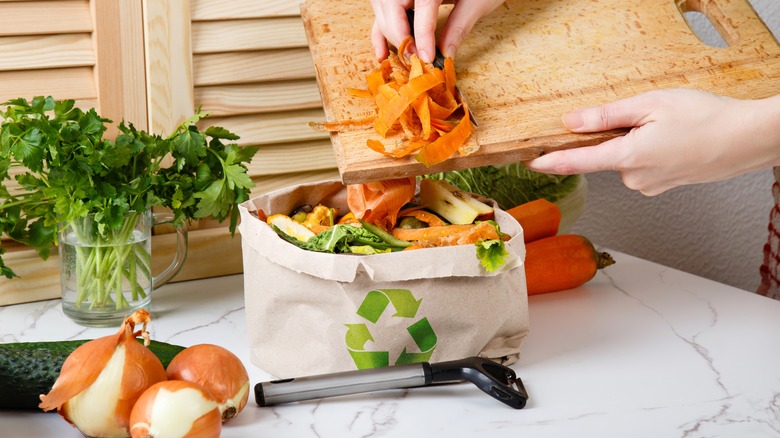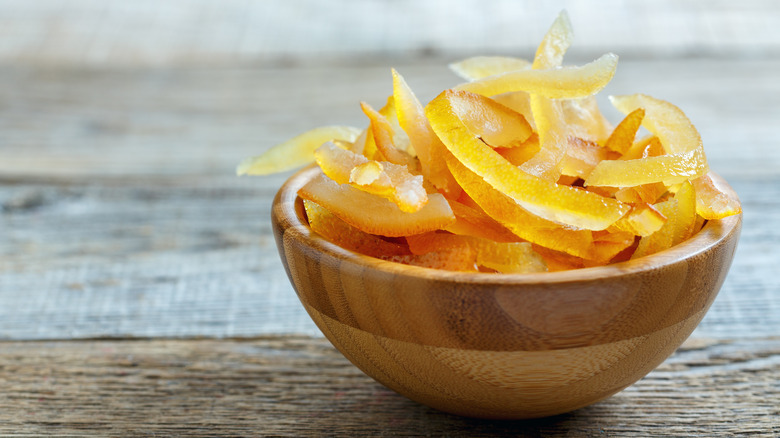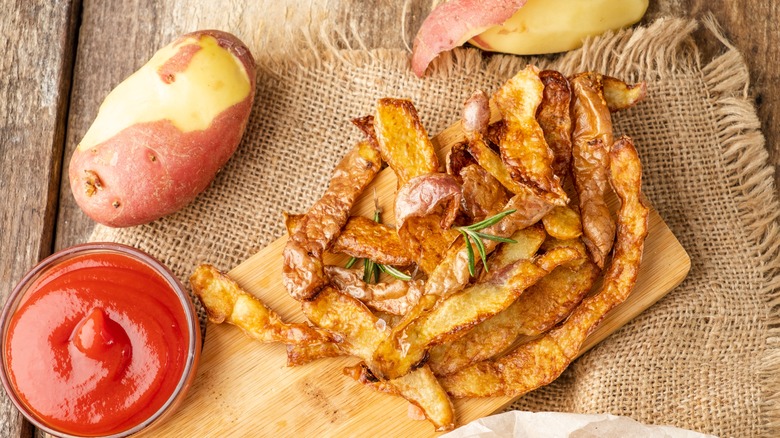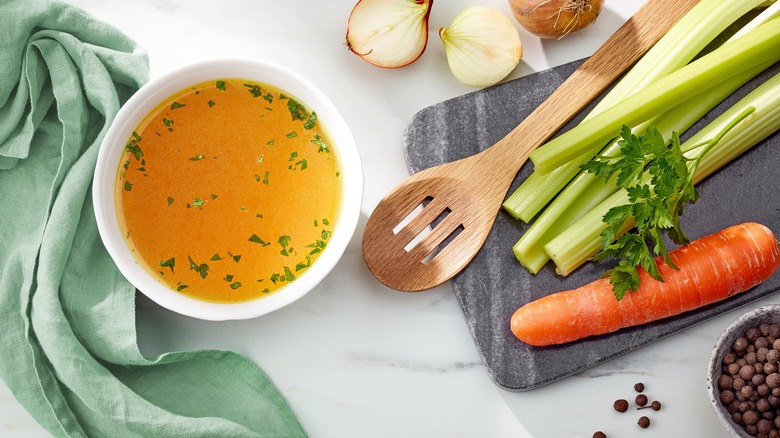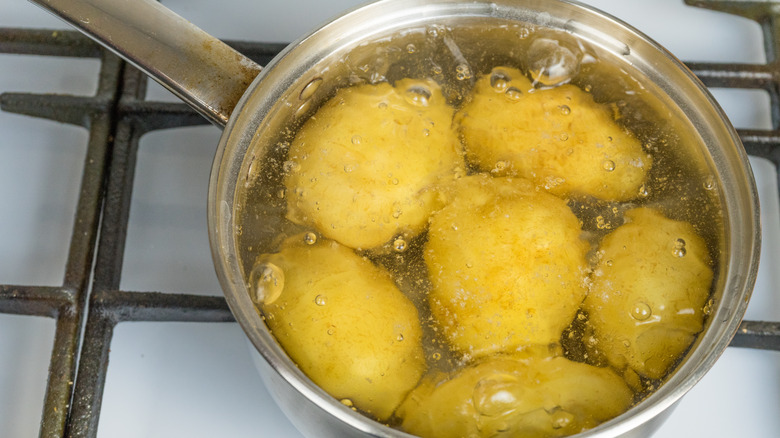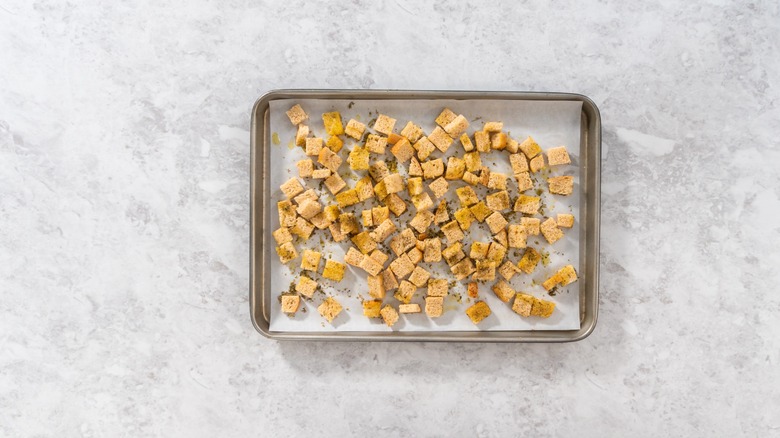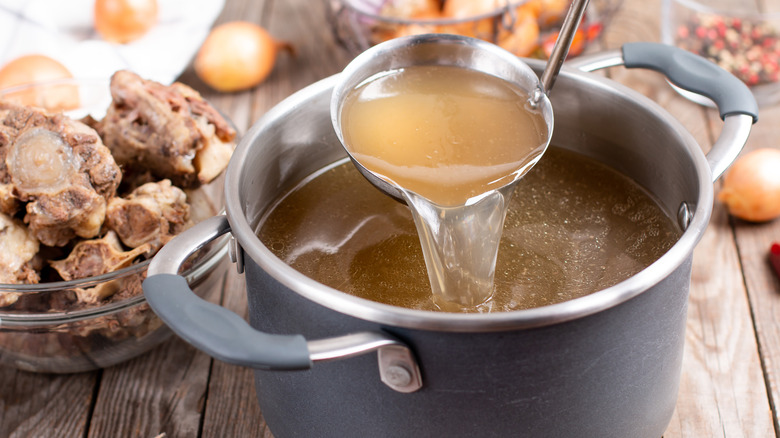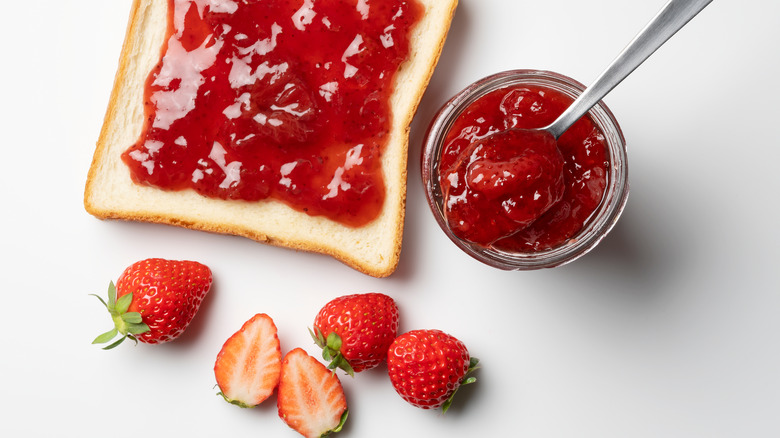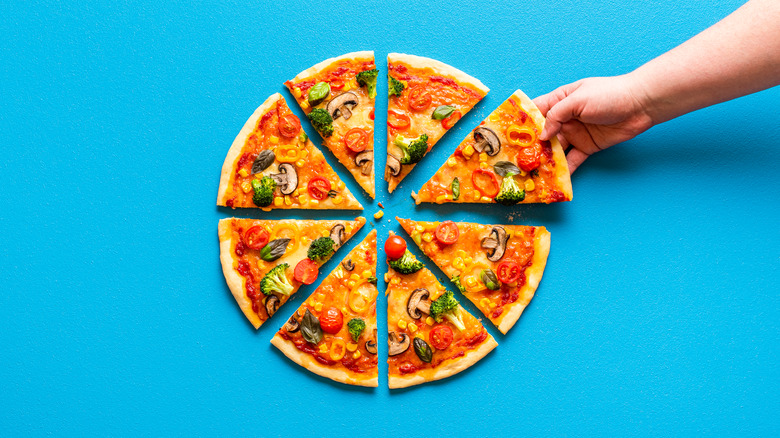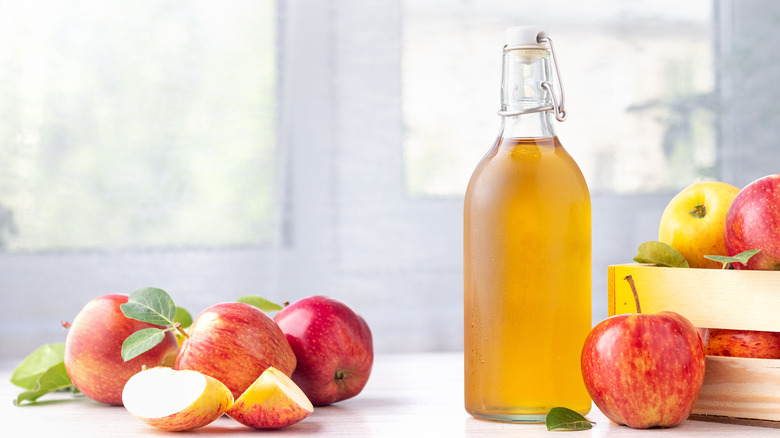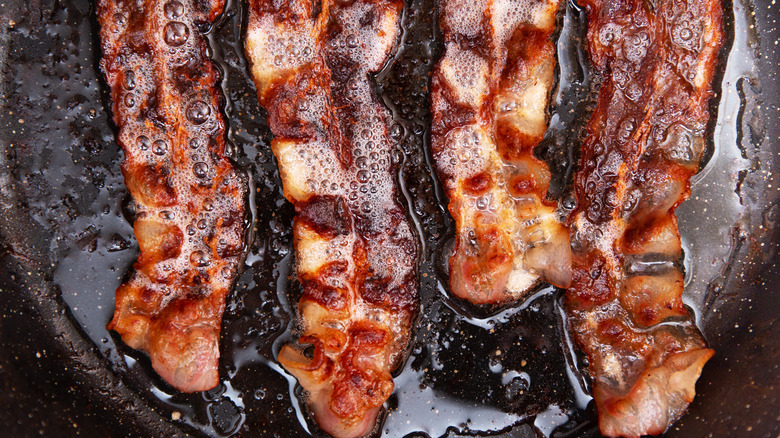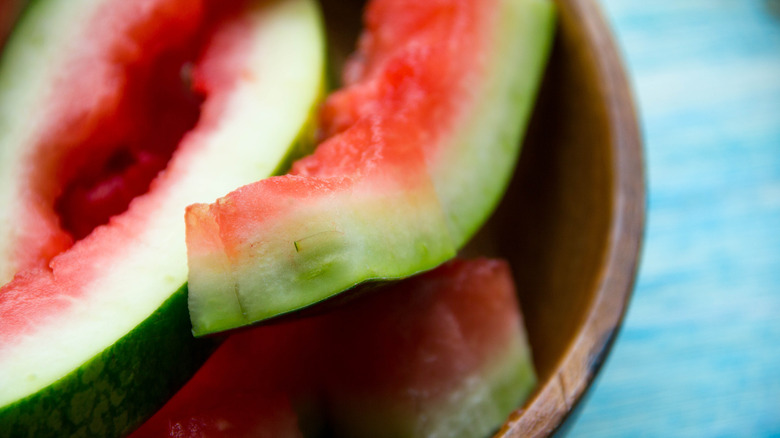Food Scraps You Can Actually Eat
The depths of your refrigerator can be daunting at times. Leftovers get pushed to the back, vegetables lose their freshness, and it may feel like you are tossing more food than you're actually eating. The idea of wasting food — even just the scraps — and contributing to the staggering food waste worldwide is less than appetizing for many reasons. Throwing food scraps in the trash can feel like tossing your hard-earned money along with it. Not to mention the huge amount of energy and resources that go into producing food, from wasted water and plastic packaging, to the workers that harvest and distribute the food.
According to World Wildlife Fund, an astounding one-third of all the food we produce ends up being thrown away. This food could not only feed hungry people around the world, but food waste also produces greenhouse gasses that are terrible for the environment and more harmful than carbon monoxide. The next time you peel a potato, find that your bread has gone stale, or you're about to throw away some carrot or celery stems, you may want to reconsider. There are endless possibilities for transforming your food scraps into something new, delicious, and often nutritious, to eat! Savor every last bite with these tips on how to utilize food scraps. You can save money and protect the environment at the same time.
Orange peels
Whether you enjoy a Cutie with your lunch, you're baking an orange cranberry cake, or you simply need to eat that bag of oranges you bought last week before they go bad, you might want to keep this trick handy. We already know oranges and other citrus fruits, such as grapefruits and even lemons, can be delicious and healthy snacks. However, the peels often leave you with a pile of food waste that typically ends up in the trash bin. One way to avoid this is to eat the peels! This might sound strange, especially since orange peels can have an extremely bitter taste to them, however, the trick is to boil out the bitterness.
Candied orange peels and lemon peels are the ultimate sustainable recipe to avoid food waste and bring a fantastic sweet treat to the table. They're easy to make, too. Cut your peels into strips to create the perfect finger food snack. Boil them at least three times, depending on how thick that light-colored pith is on the inside. Swapping out the water multiple times after it has had the chance to simmer for a few minutes will cut through the bitter taste. Once the peels have cooled, you have the option of tossing them in sugar, dipping them in chocolate, or sprinkling them with nuts for added flavor. The environment and your friends and family will thank you for the tasty treat.
Potato peels
Potatoes are truly one of the most diverse ingredients. You can boil, fry, mash, slice, dice, or chop them, and with just a little salt you have a filling, satisfying, and savory addition to any meal. Even though many people tend to ditch the peels when making dishes like mashed potatoes and potato salad, that doesn't mean the scraps have to go to waste. In fact, the skin of the potato is where you'll find many healthy nutrients, such as potassium, iron, and niacin, so leaving them in your mashed potatoes is actually a smart move.
If you must peel them, then potato peel chips are a surprisingly easy way to utilize all parts of the potato and fill your snack table or lunch box with a crunchy treat. Simply roasting your potato peels with a few everyday ingredients can transform them entirely. Toss those peels in some olive oil, avocado oil, or coconut oil, and let them roast, fry, and crisp up, either on a baking sheet in your oven or in the air fryer. You can get creative with your seasonings when it comes to potatoes as well. Add some garlic powder and Italian seasonings for something savory, or step things up with rosemary and melted brie cheese on top. Get spicy with crushed red pepper and pepperoni for a pizza flavor. Potato peel chips are an extra flavorful snack that opens the door for so many creative recipes.
Vegetable peels and stems
Have you ever noticed how quickly the scraps pile up as you slice and dice vegetables? The food waste that comes with peeling carrots, chopping celery, and readying onions and garlic can accumulate quickly. The good news is that you don't have to waste those scraps. Instead, you can save them from a landfill in the easiest way — by making your very own vegetable stock. Stock easily adds extra flavor to almost any dish, from soup and pasta to rice and risotto.
The next time you are preparing dinner, grab a medium-sized Tupperware container or a large zipper bag that is safe for the freezer. Toss any vegetable scraps into the container (up to 2 cups), such as celery, carrots, onion peels, garlic peels, herb stems, and mushrooms, and store it in the freezer.
When you are ready to make your stock, let it simmer at a very low temperature on the stove or add everything to a slow cooker. The more water you use the longer you may have to cook the stock. You can also add extra flavors with peppercorns, salt, and other added seasonings. However, remember that the stock will have plenty of flavor just from the scraps alone!
Potato water
If you watch cooking shows, then you are likely familiar with using pasta water when cooking; a few scoops can thicken your sauces and add extra flavor. But have you heard of potato water? Potato water is simply the water that you use to boil potatoes and it can be stored in your fridge for a few days or you can freeze it and add it to recipes later on. You can even freeze it in an ice cube tray to make it extra easy to add to your dishes.
Potato water works as an excellent thickening agent for soups, gravy, and sauces and can add another layer of flavor. Just add a few tablespoons or up to about 1/4 cup of water to your recipes and you won't need to use other thickening agents. This is a perfect alternative if you are trying to avoid gluten in flour or dairy in milk, cream, or butter but still want creamy, thick dishes. Potato water even has added health benefits since the root vegetable is full of potassium and vitamins B and C. Adding a few frozen cubes of potato water to your sauce is a very easy and healthy way to utilize the excess water and beef up the flavor in your cooking.
Stale bread
Is there anything worse than avoiding the heel of the bread, only to discover it's gone stale right around the time you're desperate for a morning slice of toast or a late-night sandwich? Avoid waste and transform them into tasty croutons or delicious bread crumbs. Bread crumbs are a staple in most kitchens and usually aren't too expensive, but croutons are often overlooked and a bit overpriced.
Whether you're making delicious parmesan croutons or sticking to basic bread crumbs, follow these tips for revitalizing bread scraps. Toss them into the freezer until you have enough to fill a baking sheet. For croutons, allow the bread to thaw, cut the slices into cubes, and coat them in oil along with your favorite seasonings, such as salt, pepper, garlic powder, and even parmesan cheese. Toast the bread until it is golden brown and crunchy and they will give your soups and salad a delectable crunch.
For bread crumbs, cut or tear the thawed bread into small pieces and cook them slowly at a low temperature until they are toasted and crunchy. Add some salt and other seasonings, such as Italian or garlic powder, then crumble the bread with a food processor or by hand until they are very small. Make sure the oil and bread are completely dried out before crumbling them or you might end up with soggy bread crumbs.
Bones
Bone broth is similar to vegetable stock, but it packs even more flavor and health benefits. Transforming bone scraps into healthy, delicious broth is another way to avoid food waste and save on an expensive product.
Bone broth has received a lot of attention over the past years and is being hailed as a superfood among healthy eaters. It contains collagen, minerals, amino acids, and other nutrients that are found in the actual beef, pork, and chicken bones but are usually missed when you're only eating the meat. When you add water and heat, the collagen and other vitamins within the bones and marrow break down in the water and make them easy for us to digest. All those good flavors and nutrients have been linked to better gut and digestive health, stronger hair, nails, and skin, and a reduction in stiffness and swelling in joints.
Bone broth is simple to make, with just a few ingredients needed. The first step is to place your bones and all ingredients into a large pot of water. Make sure there's enough water to cover the bones and enough for broth once some of the water evaporates. You can add vegetables, such as carrots or onions, but this isn't necessary. Allow the pot to simmer for at least 2 to 3 hours, longer if there are a lot of bones. Strain the broth and it's ready!
Fruit scraps
There's nothing quite as satisfying as your own homemade jam on a warm slice of toast or slathered on the perfect cracker. Did you know you can make homemade jam from leftover fruit scraps and juice? Save your apple peels, strawberry scraps, and more next time, and transform them into a tasty jam for your next dinner party or late-night snack.
The secret to most jams is pectin. This ingredient occurs naturally in fruit; however, not every fruit contains pectin and it can be added, especially if you are using fruit scraps. This secret ingredient is what gives fruit its shape and also creates that thick, jelly texture that most jams have. If you're using apple peels, you'll need to boil them for approximately 30 minutes. Cooking down water and sugar into syrup and adding the broken-down fruit will land you with a super tasty spread. You may have to experiment with the amount of sugar water to create your syrup and get the desired texture, but the good news is that there will always be more scraps to use!
Veggie, cheese, and meat scraps
Food waste may be a big problem, but there are so many ways to stretch food if you are willing to stay organized and get a little creative. Consider beefing up your next pizza night with some extra special toppings instead of letting your leftovers and food scraps go to waste. There are seemingly endless possibilities, from savory to sweet when it comes to pizza toppings.
Use your imagination and remember that pizza is an inexpensive way to bring life back into your food scraps. Leftover shredded chicken from the rotisserie you had last night? Add a little buffalo sauce, ranch, and mozzarella cheese and you've got a new favorite. Do you have leftover chunks of gouda or brie cheese? Top your pizza with a few sliced pears, some honey, and rosemary and even the dried-out pieces of cheese will be delicious. Are you stumped by your leftover steamed vegetables, such as corn, broccoli, and mushrooms? A veggie pizza is a quick and tasty way to get in a serving of vegetables and use up those food scraps.
Overripe fruit and cores
Fruit vinegar is another way to make use of every last apple core, strawberry top, orange peel, and more. The expression may sound strange, but if you've heard of apple cider vinegar then you already have an idea about fruit vinegar. The end result of fermented fruit juice is the perfect addition to marinades and salad dressings, which will give your meals that extra punch of flavor to blow your taste buds away. The elixir known as fruit vinegar has also recently been touted as a great way to lower blood sugar and aid in weight loss, per Healthline.
The process begins by adding your fruit scraps, overripe fruit pieces, or even whole pieces of fruit to an airtight glass jar with filtered water and leaving it for 1 to 2 weeks. The next step is to strain away the fruit leaving you with just liquid. Using the same jar, cover the liquid with cheesecloth or some other lightweight cloth and allow it to sit and ferment for 2 to 3 months. Once the fermentation process is complete you can drink the vinegar, dilute it, or add it to salad dressings and marinades. Fruit vinegar can be purchased from the store but it's also a very simple way to transform your food scraps into a beneficial addition to your cooking.
Bacon grease
Bacon grease is like cooking gold when it comes to flavor. There is a naturally salty, savory taste that goes way beyond breakfast. The grease can be slightly messy and storing it might sound like a bit of extra work, but knowing you saved some money and boosted your flavor makes it all worth it. This fatty grease can often replace olive oil or butter in certain recipes, and storing it individually in a tray and in the freezer will make the whole process easier.
The next time you're frying up a crispy breakfast of bacon, stop yourself from tossing the grease and instead grab an ice cube tray. Allow the grease to cool but not harden; it shouldn't be popping, but it should only be slightly thicker. Carefully pour the grease into an ice cube tray and that's it.
The next time you're cooking, pop a cube into a warm pan or stir it into your stir fry, vegetables, and other sauces and you'll be convinced. These dollops of bacon grease are also perfect when preparing fried eggs or potatoes and even be used in place of Crisco when baking.
High-quality olive oils and butter have become more expensive and alternatives are always great. This trick is a very simple way to save on buying other fats and avoids more food waste.
Watermelon rinds
Watermelons are a summer must-have and they offer up yet another way to reduce food waste and cut back on food scraps. The sweet pink inside of the fruit is packed with water, fiber, and downright deliciousness. However, don't forget about the often tossed-away white part of the fruit, as the watermelon rind contains many healthy nutrients. Skip the compost and the trash can and consider trying a few of these tricks the next time you have a pile of watermelon rinds.
Grab your blender, scoop out the white part of the watermelon rind, add some ice, lemon juice, and a little bit of honey and mint, and you're left with a refreshing summer smoothie to enjoy by the pool. Get creative with your flavors here.
The best part about the watermelon rinds is that they don't have a powerful taste, which means you can add them to most drinks or smoothies. The fiber in the rinds is great for digestion, reduces blood pressure, and aids in muscle recovery, which is why it's such a great addition to your diet. If you are feeling extra creative, consider pickling your watermelon rind and adding it to your salad or even a stir-fry.
